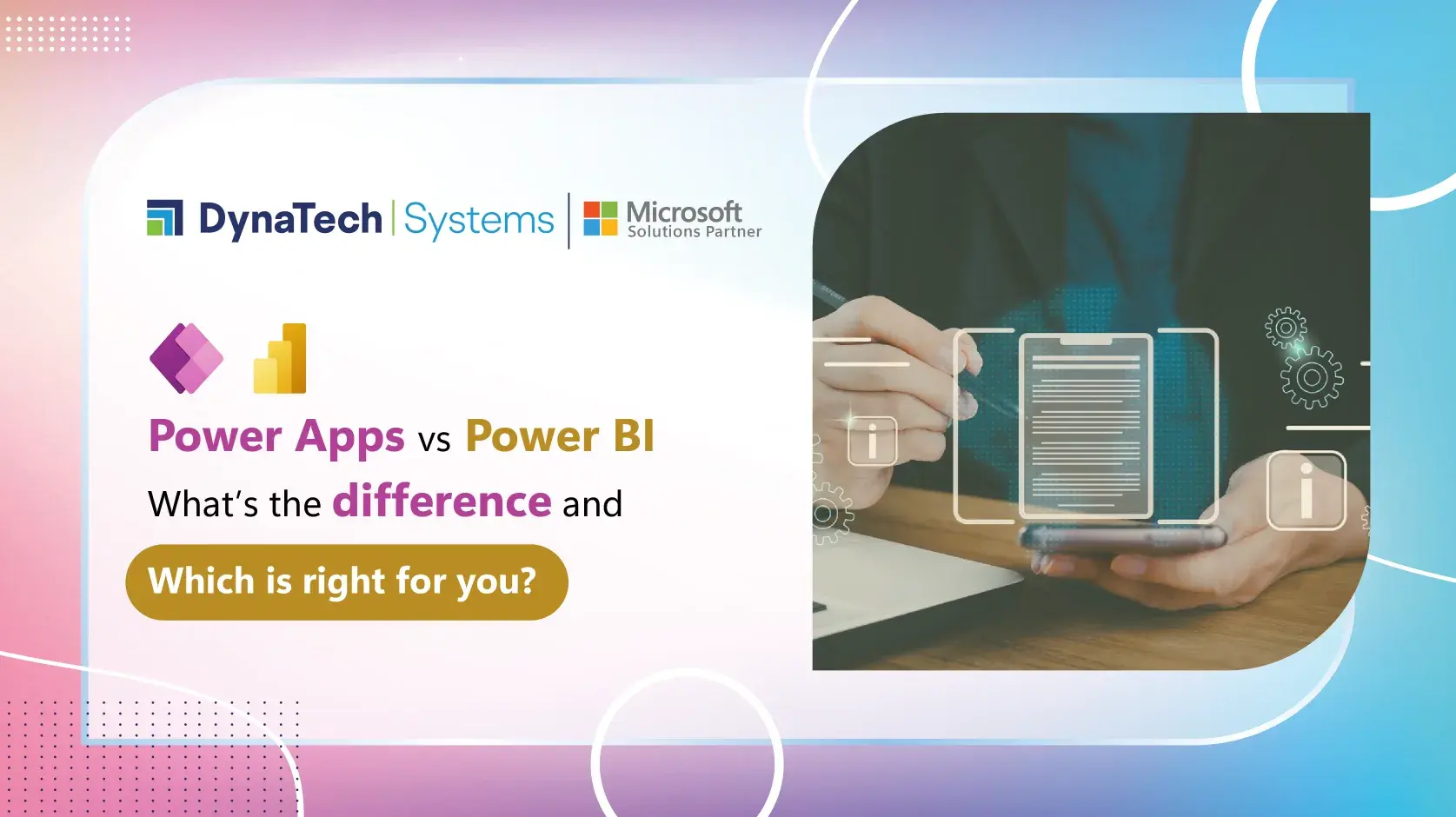Enterprises are continuously seeking innovative solutions to streamline their operations, analyze data effectively, and empower their employees. Microsoft has emerged as a frontrunner in providing tools and platforms that cater to these needs, with Power Apps and Power BI standing out as two prominent offerings in their Power Platform suite. However, understanding the differences between Power Apps and Power BI is crucial for businesses to choose the right tool for their specific requirements. In this blog, we will showcase the disparities between Power Apps and Power BI and guide you toward making an informed decision.
Power Apps: Building Custom Applications with Ease
Power Apps is a low-code/no-code platform that empowers users to build custom applications without the need for extensive programming knowledge. It enables businesses to create tailored solutions to address various needs, such as automating processes, managing data, and enhancing productivity across different departments.
Key Features of Power Apps
- Drag-and-Drop Interface: One of the most notable features of Power Apps is its intuitive drag-and-drop interface, which allows users to design applications visually without writing a single line of code. This makes the app development process accessible to a variety of users, including business analysts and citizen developers.
- Integration with Data Sources: Power Apps seamlessly integrate with a variety of data sources, including Microsoft 365, SharePoint, Dynamics 365, and SQL Server, enabling users to leverage existing data in their applications. This integration enables users to have real-time information access and can make data-driven decisions within their apps.
- Customization and Branding: With Power Apps, users can customize the look and feel of their applications to align with their brand identity. Be it choosing color schemes or fonts to add logos and branding elements, Power Apps renders top-notch customization options that allow businesses to create visually appealing and cohesive experiences for their users.
- Responsive Design: Power Apps applications are built with responsive design principles in mind to ensure that they seamlessly adapt to a variety of screen sizes and devices. Whether users access the application on a desktop computer, tablet, or mobile phone, they can expect a consistent and optimized experience.
Power BI: Unlocking Insights from Data
Power BI is a business analytics tool that enables organizations to visualize and analyze data to gain actionable insights and make informed decisions. It empowers users to create interactive reports and dashboards that convey complex information in a visually compelling manner, facilitating data-driven decision-making across the organization.
Key Features of Power BI
- Data Visualization: Power BI offers a wide range of interactive visualization options, including charts, graphs, maps, and gauges, allowing users to explore data and uncover patterns and trends easily. These visualizations can be easily customized and integrated to create rich, informative reports and dashboards that convey insights effectively.
- Data Modeling and Transformation: Power BI provides robust data modeling and transformation capabilities that enable users to shape and manipulate data from multiple sources. Whether it’s cleaning and organizing data, creating relationships between different datasets, or defining calculations and measures, Power BI offers tools to ensure that data is optimized for analysis.
- Advanced Analytics: In addition to basic reporting and visualization features, Power BI offers advanced analytics capabilities, such as predictive analytics and machine learning integration. Users can leverage these tools to perform sophisticated analyses, forecast future trends, and make data-driven predictions to drive business growth.
- Integration with External Services: Power BI seamlessly integrates with a lot of external services and applications, including Azure services, SQL Server Analysis Services, and Microsoft Excel. This integration enables users to leverage additional capabilities and extend the functionality of Power BI to suit their specific needs.
Key Similarities between Power Apps and Power BI
- Microsoft Ecosystem: Both Power Apps and Power BI are part of Microsoft’s Power Platform, which also includes Power Automate (formerly known as Microsoft Flow) and Power Virtual Agents. This integration enables seamless collaboration and interoperability between the different tools, enabling users to leverage data and automate processes effectively.
- Low-Code/No-Code: Both Power Apps and Power BI are designed to be low-code/no-code platforms, making them accessible to different users with varying levels of technical expertise. This empowers citizen developers and business analysts to create solutions and analyze data without the need for extensive programming knowledge, thereby accelerating development cycles and increasing productivity.
- Integration with Data Sources: Both Power Apps and Power BI offer robust integration capabilities, allowing users to integrate various data sources, including Microsoft 365, Dynamics 365, SQL Server, SharePoint, Excel, and more. This integration enables users have access to real-time data and can leverage existing datasets within their applications and reports.
- Cloud-Based Deployment: Both Power Apps and Power BI are cloud-based solutions, which means they are hosted on Microsoft Azure and can be accessed from anywhere with an internet connection. This cloud-based deployment model offers scalability, reliability, and accessibility, allowing organizations to deploy and manage applications and reports with ease.
Key Differences between Power Apps and Power BI
- Purpose and Functionality: The primary difference between Power Apps and Power BI lies in their purpose and functionality. Power Apps is focused on application development and process automation, enabling users to build custom applications and automate workflows. On the other hand, Power BI is centered around data analysis and visualization, allowing users to create interactive reports and dashboards to derive insights from data.
- Data Manipulation: Power Apps primarily deals with data input, storage, and retrieval within the created applications, focusing on managing and interacting with data within a business context. Power BI focuses on data transformation, cleaning, and modeling to create comprehensive visualizations and reports, enabling users to derive insights and make data-driven decisions.
- Target Audience: Power Apps is primarily targeted towards citizen developers, business analysts, and IT professionals who need to build custom applications and automate processes within their organizations. Power BI, on the other hand, is aimed at business users, data analysts, and decision-makers who need to analyze data, derive insights, and make data-driven decisions.
- Skill Requirements: Power Apps requires less coding expertise, making it accessible to citizen developers and non-technical users who can leverage its low-code/no-code capabilities. Power BI demands a deeper understanding of data modeling, querying languages, and visualization best practices, making it suitable for data professionals and analysts who need to analyze and visualize complex datasets.
Choosing the Right Tool for Your Business
Now that we’ve explored the key differences between Power Apps and Power BI, the question arises: which tool is right for your business? The answer largely depends on your organization’s unique requirements and objectives.
When to Choose Power Apps?
- Process Automation: If your primary goal is to streamline business processes and automate repetitive tasks, Power Apps is the ideal choice. Its low-code/no-code approach allows users to quickly build custom applications to digitize workflows and improve efficiency.
- Custom Application Development: If you need to develop custom applications tailored to specific business needs, Power Apps provides the flexibility and agility to create solutions rapidly. Whether it’s a simple data entry app or a complex business application, Power Apps empowers users to bring their ideas to life without relying on traditional development cycles.
When to Choose Power BI?
- Data Analysis and Visualization: If your focus is on analyzing data, gaining insights, and visualizing information to support decision-making, Power BI is the preferred tool. Its robust analytics capabilities enable users to explore data dynamically, create interactive reports and dashboards, and share insights across the organization.
- Business Intelligence and Reporting: If you need to deliver actionable insights to stakeholders and executives, Power BI offers powerful business intelligence and reporting features that facilitate data-driven decision-making. Whether it’s tracking key performance indicators (KPIs), monitoring business metrics, or identifying trends, Power BI empowers users to extract value from data effectively.
Conclusion
In conclusion, Power Apps and Power BI are two powerful tools within Microsoft’s Power Platform suite, each serving distinct purposes in the realm of business applications and data analytics. While Power Apps is geared towards building custom applications and automating processes, Power BI excels in data analysis, visualization, and business intelligence. By understanding the differences between these tools and assessing your organization’s needs, you can choose the right tool to drive innovation, efficiency, and growth within your business. Whether you’re empowering employees with custom applications or unlocking insights from data, Microsoft’s Power Platform has you covered.
Are you ready to leverage the power of Microsoft's Power Platform for your organization's needs? Whether you're looking to automate workflows, analyze data, or enhance productivity, our experts are here to help.




























